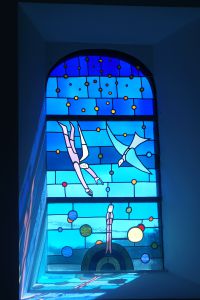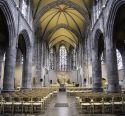Church | 1050 | Romanesque | Catholic Church


Map
Opening hours
01 January - 31 December
Mon 9.00 - 18.00
Tue 9.00 - 18.00
Wed 9.00 - 18.00
Thu 9.00 - 18.00
Fri 9.00 - 18.00
Sat 9.00 - 18.00
Sun 9.00 - 18.00
Guided tour
Maison du Tourisme Famenne-Ardenne Ourthe & Lesse
+32 84 34 53 27 - info@famenneardenne.be
Religious offices
Wednesday 6 pm
Sunday 9.30 am
Deanery website
Description
This remarkable edifice dating from 1050 is the oldest Romanesque church in the country. It is the only one that has kept the dedicatory stone that commemorates the consecration of the church on 20 June 1050.
The external framework is pleasing, with the very old cemetery that surrounds the church and the ancient lime tree very close by. The building was constructed to a very simple plan: a central part and two side parts that are less elevated. The church has been maintained to a great extent in the original state of primitive Romanesque churches: small size, soberness, simplicity of the construction, equilibrium of the proportions.
It contains interesting furnishing, in particular the works of the master of Waha, superb statues of saints, the baptismal tank and, the only contemporary element, stained glass windows done by Louis-Marie Londot and by Jean-Michel Folon which recall the martyrdom of Saint Stephen.
KIKIRPA : Photo-library online
Photos
Media
Remarkable elements
White Monk Curé
This remarkable Romanesque building, listed as Wallonia's Major Heritage Site, is surrounded by its former cemetery and preceded by a centuries-old lime tree under which a White Curate monk meditates. It depicts a monk, dressed in a habit, in a position of prayer.
Commemorative stone
A stone commemorating the consecration of the church by the Prince-Bishop of Liège, Théoduin of Bavaria, bears the date 1050, Wednesday 20 June (the year of the Incarnation of the Lord). This stone is a rare piece of historical evidence from the period that has survived to the present day. It also bears witness to the epigraphic art of the Middle Ages.
Statues of the Master of Waha
A fine collection of highly expressive statues by the "Master of Waha" dating from the 16th century (coincidentally, most of them are made of limewood).
The statue of St James and the Calvary are the most representative works by this artist.
Stained glass windows
The 6 stained glass windows in the nave are the work of artist Jean-Michel Folon. Dating from 2004 and 2005, they illustrate scenes from the life of Saint Stephen (taken from the book of the Acts of the Apostles) and his legend, which developed later, with a fabulous play of colour.
The theotheca
In the Middle Ages, the Blessed Sacrament could be kept in a simple niche that was once closed by a small iron door in the side wall of the chancel, known as a theotheca or Eucharistic turret. The oculus opening onto the outside of the building allowed the faithful to approach the Blessed Sacrament without entering the church.
























